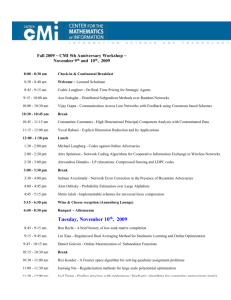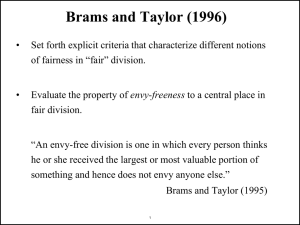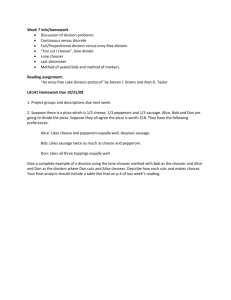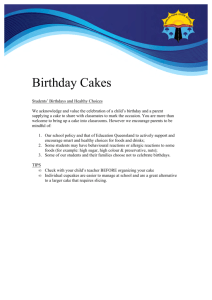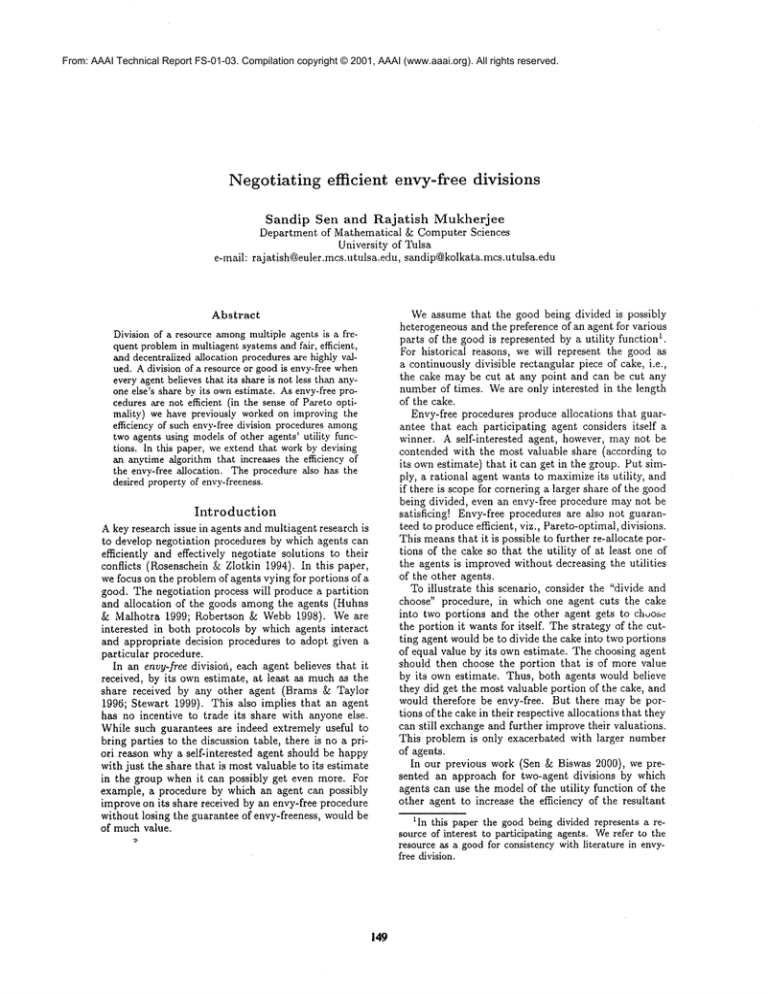
From: AAAI Technical Report FS-01-03. Compilation copyright © 2001, AAAI (www.aaai.org). All rights reserved.
Negotiating efficient
envy-free divisions
Sandip
Sen and Rajatish
Mukherjee
Department of Mathematical ~; Computer Sciences
University of Tulsa
e-maih rajatish@euler.mcs.utulsa.edu,
sandip@kolkata.mcs.utulsa.edu
Weassume that the good being divided is possibly
heterogeneous and the preference of an agent for various
t.
parts of the good is represented by a utility function
For historical reasons, we will represent the good as
a continuously divisible rectangular piece of cake, i.e.,
the cake may be cut at any point and can be cut any
number of times. Weare only interested in the length
of the cake.
Envy-free procedures produce allocations that guarantee that each participating agent considers itself a
winner. A self-interested
agent, however, may not be
contended with the most valuable share (according to
its ownestimate) that it can get in the group. Put simply, a rational agent wants to maximizeits utility, and
if there is scope for cornering a larger share of the good
being divided, even an envy-free procedure may not be
satisficing! Envy-free procedures are also not guaranteed to produceefficient, viz., Pareto-optimal, divisions.
This meansthat it is possible to further re-allocate portions of the cake so that the utility of at least one of
the agents is improved without decreasing the utilities
of the other agents.
To illustrate this scenario, consider the "divide and
choose" procedure, in which one agent cuts the cake
into two portions and the other agent gets to choose
the portion it wants for itself. Thestrategy of the cutting agent would be to divide the cake into two portions
of equal value by its own estimate. The choosing agent
should then choose the portion that is of more value
by its own estimate. Thus, both agents would believe
they did get the most valuable portion of the cake, and
would therefore be envy-free. But there may be portions of the cake in their respective allocations that they
can still exchangeand further improve their valuations.
This problem is only exacerbated with larger number
of agents.
In our previous work (Sen & Biswas 2000), we presented an approach for two-agent divisions by which
agents can use the model of the utility function of the
other agent to increase the efficiency of the resultant
Abstract
Division of a resource amongmultiple agents is a frequent problemin multiagentsystemsand fair, efficient,
and decentralized allocation proceduresare highly valued. A division of a resource or goodis envy-free when
everyagent believes that its share is not less than anyone else’s share by its ownestimate. Asenvy-free procedures are not efficient (in the sense of Pareto optimality) we have previously worked on improving the
efficiency of such envy-free division procedures among
two agents using modelsof other agents’ utility functions. In this paper, we extend that workby devising
an anytimealgorithm that increases the efficiency of
the envy-free allocation. The procedure also has the
desired property of envy-freeness.
Introduction
A key research issue in agents and multiagent research is
to develop negotiation procedures by which agents can
efficiently and effectively negotiate solutions to their
conflicts (Rosenschein & Zlotkin 1994). In this paper,
we focus on the problemof agents vying for portions of a
good. The negotiation process will produce a partition
and allocation of the goods among the agents (Huhns
& Malhotra 1999; Robertson & Webb 1998). We are
interested in both protocols by which agents interact
and appropriate decision procedures to adopt given a
particular procedure.
In an envy-free divisioli, each agent believes that it
received, by its own estimate, at least as muchas the
share received by any other agent (Brams & Taylor
1996; Stewart 1999). This also implies that an agent
has no incentive to trade its share with anyone else.
While such guarantees are indeed extremely useful to
bring parties to the discussion table, there is no a priori reason why a self-interested agent should be happy
with just the share that is most valuable to its estimate
in the group when it can possibly get even more. For
example, a procedure by which an agent can possibly
improve on its share received by an envy-free procedure
without losing the guarantee of envy-freeness, would be
of muchvalue.
1In this paper the good being divided represents a resource of interest to participating agents. Werefer to the
resource as a goodfor consistency with literature in envyfree division.
149
division. The division was guaranteed to be envy-free
and was proven to be optimal when such an allocation
involved the assignment of a contiguous portion of the
cake to one agent. Wewill refer to this procedure as
’de-opt.
In the present work, we will focus on the problem
of improving the efficiency of envy-free divisions among
two agents by reeursively dividing, using 2e-opt, the
initial partitions produced. While our previous work
shows that there does not exist a guarantee optimal
envy-free division in general, the procedure presented
here can improve the efficiency of divisions that agents
can negotiate by using 2e-opt. The procedure also has
the desired property of improving the efficiency of the
division monotonically with time.
To set the context for this work, we will summarize
the requisites of fair division processes, the framework
for negotiation, and the algorithm 2e-opt from our previous work. Wewill then present the recursive algorithm that is the contribution of this paper.
Division
of a good
Weconcern ourselves with the problem of dividing up a
good between multiple individuals. Wewill assume that
the solution procedure is of a decentralized nature. This
meansthat the agents will be required only to abide by
a protocol by which the division is to be made. They
can freely choose any strategy to use to determine their
actions within the accepted protocol.
For example, a protocol used in auction settings may
require that every agent submit a sealed bid for the
good to an auctioneer. After every bid is collected, the
good is divided up among the bidders in proportion
to their bids. Our assumption is that once the agents
agree to such a protocol, they are free to choose their
bids following any strategies they adopt. Werequire,
however, that agents will agree to the division of the
good as specified once they have placed their bids.
Froma designer’s point of view, the choice of a protocol provides a platform for agents to negotiate an
agreeable division. The choice of a strategy will be dictated by concerns for arriving at a preferred share of the
good being divided. The protocol designer should then
provide protocols which can be used by agents to successfully negotiate agreeable divisions with reasonable
computational costs. Wenowlist properties of divisions
that can makethem agreeable to self-interested agents.
Desired characteristics
of divisions
Weassume that a single divisible good is to be divided amongn agents. The following criteria have been
espoused as desirable characteristics of decision procedures or outcomes from such procedures (Brams ~ Taylor 1996):
Proportlonah Each agent believes that it received, by
its own estimate, at least ~ of the goods being allocated.
150
Envy-free: Each agent believes that it received, by its
own estimate, at least as valuable a share as that
received by any other agent. This also implies that an
agent has no incentive to trade its share with anyone
else.
Equitable: A solution, i.e., a partition of the good
amongthe n agents, is equitable, whenthe share received by each agent is identical in terms of their
individual utility functions.
Efficient: A solution is said to be Pareto optimal or efficient if there is no other partition whichwill improve
the perceived share of at least one agent without decreasing the perceived share of any other agent.
Envy-free
divisions
with improved
efficiency
Weassume that the continuously divisible good is possibly heterogeneous and the preference of an agent for
various parts of the good is represented by a utility
function. For historical reasons, we will represent the
good as a rectangular piece of cake. For all practical
purposes, however, we are only interested in the length
of the cake. Though we present the 2e-opt negotiation procedure from our previous work (Sen ~ Biswas
2000) here for completeness, at first glance the reader
can simply use the results from the following theorems
to facilitate understanding of the discussion about the
extended protocol in the later sections of this paper.
The utility to the ith agent of a piece of the cake
cut between points a and b (where a < b) is given
[~Ui(z)dz, where Ui(x) is the utility function of the
ith agent. Without loss of generality, we will assume
that the first agent is having a model,/-/2, of the utility
function of the second agent. This model need not be
accurate, but the better the model, the more benefit
the modeling agent stands to gain by using it.
The 2e-opt procedure we now describe is derived
from Austin’s moving knife procedure (Brams & Taylor
1996). In the 2e-opt procedure (Sen & Biswas 2000),
the modeling agent A hold two knives parallel to the
side edges of the cake and then movethem to the right
allowing for wrap around. Let the positions of the left
and right knives at time t be It and rt respectively, l0
and r0 determine the initial region offered to B. The
knives stop at time t = T when the right knife reaches
the original position of the left knife, and the left knife
reaches the original position of the right knife. The
agent B then chooses a time r < T, and the portion
of the cake in between l~ and r~ (with wrap-around if
needed) is given to B, with the rest of the cake going
to agent A (see Figure 1).
It can be shown that B can always negotiate an envyfree division for itself if it calls "cut" at an appropriate
time irrespective of how A movesthe knife. B, however,
can be resentful as it can presumethat the advantage of
moving the knife allows A to obtain a super-equitable
share for itself, which guarantees a sub-equitable share
for B (Sen & Dutta 2001).
Region
allocated
toB
Left
knife
Theorem I Our scheme dominates Austin’s
with respect to efficiency of allocations.
Right
knife
Figure 1: Our augmentation of Austin’s procedure with
the modeling agent moving two knives.
Wenow specify the choice of the initial region, the
choice of the target region that the modeler wants the
other to choose, and a way of moving the knife such
that this target region is most likely to be chosen by
the other agent.
Initial region selection: The initial knife placements
should be such that f~UA(x)dx = ~fl
1 Ua(x)dx,
where L is the length o~ the cake. It is also desirable
that the region in between does divide the cake in half
for agent B. OtherwiseB mayfind it beneficial to choose
t = 0 (if, according to B’s estimate, the region (n,
is the most valuable) or t = T (if, according to B’s estimate, the region (re, n) is the most valuable).
a contiguous region that satisfy both these conditions
may not be found in general. So, the initial placement
(m, n) should also satisfy the following condition:
(re, n) = argmin fY’~B(z)dz l-’2
foL-u--BB(Z)dz
Y,=J~:
knifes such that the corresponding region is the most
attractive offer received by B. If X is empty, however,
A will have to be satisfied with half of the cake.
Moving the knife: While moving between pairs
of points as identified in the previous paragraph,
the knife locations (u,v) should satisfy the following
¯
¯
v-L-,
lnequahty:f:
UB(x)dx < ~1 fo
UB(x)dx. For regions
where A’s utility is high, the spacing betweenthe knives
will be reduced to make that region non-envy-free for
B.
An instance of the above procedure is shown in Figure 2. Wepresent some properties of this decision procedure (for proof see (Sen ~5 Biswas 2000)):
.
For ease of exposition, if y < x, we use fff f(z)dz to
represent fL f(x)dx + fYo f(z)dz.
Target re~gion selectiVon: The target region must
result in an envy-free division. Eliminating beginning and end points, the target region should be
selected
from the following set: Z = {(x,y)
rT
(f:~(z)dz 0> ma~(f,~v.(x)d~,f~
U.(x)dx))
(f[ Ua(z)dz
<~1 foL U~(~)dz)}.
Fromthe regions in Z, we filter out those r.eygions that
are of least value to A: Y = argmin(~.y)ez f~ UA(z)dz.
From the regions in Y, A can select those regions
which are estimated to be of most value to B: X =
Y
argmax(,,y)ey f~ "~B(z)dz. This maximizing choice
can be viewed either as a cooperative gesture or as an
attempt to improve the likelihood of B accepting what
A would prefer it to accept. If X is non-empty, then A’s
goal is to select one of its elements and then movethe
procedure
Theorem 2 If a Pareto-optimal allocation for a problem involves a contiguous region, our proposed scheme
will select it when given an accurate agent model.
Recursive
division
to improve optimality
The protocol 2e-opt guarantees an envy-free division
among two agents that is more optimal than Austin’s
moving knife procedure (Austin 1982). The division obtained after applying 2e-opt will be Pareto-optimal only
if there exists somecontiguous Pareto-optimal allocation in the good. In a large majority of cases, however,
such a contiguous Pareto-optimal allocation may not
exist¯ Under such circumstances, we propose an augmented procedure to increase the efficiency of the allocation without affecting the envy-free guarantee. We
now present a time-constrained procedure (with timelimit T) that recursively invokes itself, checking at each
stage if further improvementsare feasible. The input to
this procedure consists of the envy-free division of the
cake into two portions (portion X for agent A and portion Y for agent B) obtained after applying 2e-opt or
any other envy-free division procedure. The algorithm
is presented in Figure 3.
The above algorithm combines and encapsulates both
the specification of a protocol, i.e., whenagents communicate and the roles played by each agent in the division
process, and the strategy adopted for negotiation, i.e.,
what portions are offered by one agent and which portion is selected by the other. This negotiation procedure
is decentralized as each agent is in control of what to
offer and accept. Such a procedure can be used both
in a cooperative and competitive scenario. In the competitive scenario, the modeler will be interested only
in maximizing its own share of the good. In a cooperative scenario agents can negotiate more efficient and
equitable divisions by truthfully revealing their preferences or utilities (incorrect utility estimates can limit
the performance of 2e-opt and 2e-optR but they will
still produceenvy-free divisions).
Weillustrate this process by considering two agents
A and B. Let us assume that an envy-free division
has produced an allocation of portion X to agent A
151
G
(a)
Initial position
(b)
(c)
ii~,~!
~~i,!~i~il~i
i,i~i!i!~i~i
~’!~
R
(d)
R
,L
i
t
(e)
I
’~
i
i
Final position
Figure 2: Knife-movingprocedure snapshots (G: target region; L,R: left, right knife).
and portion Y to agent B. Now, 2e-opt is applied on
both X and Y dividing it into portions (XA,Ys) and
(YA,YB) respectively.
This means that if X were to
be the only portion to be divided up between A and
B, then (XA, Xs) would be an envy-free division with
A receiving Xa and B receiving XB, i.e., XA (XB) is
the more valuable portion of X in A’s (B’s) estimate.
Note that (XA, XB) is not the optimal envy-free division possible, but the one that is computedby 2e-opt.
Similar reasoning holds for the portion Y. There exists
a plausible exchange between A and B if A believes YA
is more valuable than Xs, and B believes that XB is
more valuable than YA. This process is illustrated in
Figure 4. Wehave illustrated only a single step of our
algorithm. After the exchange is complete, the algorithm recursively calls 2e-optR over the newallocations.
The above algorithm will return an envy-free allocation at least as efficient as the ~2e-opt procedure. Also,
if A and B have non-conflicting areas of interest within
the cake, the above algorithm guarantees a more efficient solution than that achieved by Austin’s two person
envy-free allocation procedure. Our algorithm 2e-optR
152
terminates if A and B decide not to exchange any portion at a particular iteration or if the running time has
exceeded T.
Figure 4 illustrates a possible iteration of our efficient
envy-free division algorithm. Envy-free allocation for A
and B (at the start of the algorithm) is shown. Given
that A likes Y_Amore than X_Band similarly B likes
X_Bmore than Y_A, we can exchange these portions to
achieve more efficiency.
Discussion
In our prior work we presented an algorithm that produced optimal envy-free divisions of continuously divisible goods between two agents under certain assumptions of utility functions (Sen & Biswas 2000).
this work, we have introduced a recursive extension (of
course, an equivalent iterative version would do just as
well) of the previous protocol that results in an anytime
algorithm which monotonically increases the optimality
of envy-free divisions with available computation time.
It is quite likely that such an extension would follow the law of diminishing returns. That implies that
Procedure2e-optR(X,Y,T)
// T is the maximumrunningtime; X, Y are initialallocations
{
if (T=O) // if time has elapsed
return(X,Y);// return new allocations
else
Divide portionX into portion{X_A,X_B}using 2e-opt;
Divide portionY into portion{Y_A,Y_B}using 2e-opt;
if (Utility_A(X_B)
<= Utility_A(Y_A)
Utility_B(Y_A)
<= Utility_B(X_B))
{// if envy-freeexchangepossible,exchangeX_B with Y_A
X <- X_A U Y_A;
Y <- X_B U Y_B;
return 2e-optR(X,Y,(T-C));//
Time taken for this call = C
}
else // no more exchangepossible
return(X,Y);
Figure 3: The 2e-optR negotiation procedure.
the earlier exchanges are likely to produce greater increase in efficiency compared to latter exchanges. The
computation costs of each negotiation stage should be
roughly the same. This raises the issue of a tradeoff between computation cost and efficiency improvement. If
the negotiation is done off-line or with a fixed time limit
as we have assumed, the termination criteria should be
as used here. If the agents are interested in factoring in
computation costs, however, negotiation can possibly
be terminated when the expected gain from the next
negotiation stage is less than the computational cost of
participating in that stage.
Wehave presented a procedure that improves the efficiency of n agent envy-free divisions (Nuchia 83 Sen
2001). The difference of this work from the approach
above is that we assume an initial envy-free allocation
and try to improveon that allocation in efficiency without sacrificing the envy-free property.
We are working on extending our envy-free division method to more than two agents. In the general
case of n agents, no envy-free division procedure exists. Hence, we would be interested in augmenting approximately envy-free division procedures, where allocations are envy-free within some pre-specified errorbounds (Brams & Taylor 1996). The 2e-optR algorithm, can be utilized to improve the optimality of an
already existing envy-free division amongn agents. For
example, for n = 3, an envy-free allocation divides the
cake into three portions. Wecan apply the 2e-optR algorithm for two persons for every pair of agents. We
allow exchange between two agents if both agree and
the third agent does not object, i.e., the resultant allocation after the exchange does not make the third agent
envious. The problem is similar to the multi-agent contract problem which consists of exchanges between all
agents (Andersson & Sandhohn 1999). However, our
problem is more difficult because multi-agent contracting is concerned only with individual rationality (no
agent will enter into a contract that leaves it worseoff), whereas in this case we have to additionally ensure that all agents remain envy-free after a possible
exchange between any two agents.
Andersson, M. R., and Sandhoh-a, T. W. 1999. Timequality tradeoffs in reallocative negotiation with combinatorial contract types. In Sixteenth National Conference on Artificial Intelligence, 3-10. Menlo Park,
CA: AAAIPress/MIT Press.
Austin, A. 1982. Sharing a cake. Mathematical Gazette
66(437):212-15.
Brams, S..J., and Taylor, A. D. 1996. ~hir Division:
From cake-cutting to dispute resolution. Cambridge
University Press, Cambridge: UK.
Huhns, M. N., and Malhotra, A. K. 1999. Negotiating
for goods and services. IEEE Internet Computing3(4).
Acknowledgments This work has been supported
part by an NSF CAREERaward IIS-9702672.
in
References
Nuchia, S. W., and Sen, S. 2001. Improving optimality of n agent envy-free divisions. In PreProceedings of the Eighth International
Workshop
on AGENT THEORIES,
ARCHITECTURE,
AND
LANGUAGES, 208-217.
Robertson, J., and Webb, W. 1998. Cake Cutting
Algorithms. Natick, MA:A. K. Peters.
Rosenschein, J. S., and Zlotkin, G. 1994. Designing
conventions for automated negotiation. AI Magazine
29-46.
153
Piece
Y
Piece
V
X
I
i
l
i
i
X__B
Agents:
A
&
’
X__A
B.
Figure 4: A plausible envy-free exchange between agents A and B.
Sen, S., and Biswas, A. 2000. More than envyfree. [n Proceedings of Fourth International Conference on MultiAgent Systems, 433-434. Los Alamitos,
CA: IEEE Computer Society.
Sen, S., and Dutta, P. S. 2001. Envy and spite free
divisions. In Working Notes of the Fourth Workshop
on Deception, Fraud and Trust in Agent Societies, 7190.
Stewart, I. 1999. Mathematical recreations: Division
without envy. Scientific American.
154

